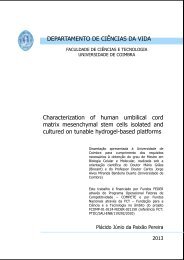Regulation of Apoptosis and Differentiation by p53 in Human ...
Regulation of Apoptosis and Differentiation by p53 in Human ...
Regulation of Apoptosis and Differentiation by p53 in Human ...
You also want an ePaper? Increase the reach of your titles
YUMPU automatically turns print PDFs into web optimized ePapers that Google loves.
CHAPTER 1: Introduction<br />
Cardiomyocytes H9.2 Evaluation <strong>of</strong> ultrastructural <strong>and</strong> proliferative<br />
characteristics<br />
Cardiomyocytes H9.2 Evaluation <strong>of</strong> electrophysiological <strong>and</strong><br />
pharmacological properties<br />
Cardiomyocytes H1 Demonstration <strong>of</strong> functional <strong>in</strong>tegration after<br />
transplantation <strong>in</strong>to gu<strong>in</strong>ea pig model<br />
Hematopoietic H1, H1.1, <strong>Differentiation</strong> <strong>of</strong> multipotent hematopoietic<br />
colony-form<strong>in</strong>g H9.2 precursors<br />
cells<br />
Hematopoietic H1, H9 <strong>Differentiation</strong> <strong>of</strong> multipotent CD45 +<br />
progenitor cells<br />
hematopoietic precursors<br />
Hematopoietic H1, H9 <strong>Differentiation</strong> <strong>of</strong> multipotent CD34 +<br />
progenitor cells<br />
Hemangioblasts H1, H7,<br />
H9, MA01,<br />
MA03,<br />
MA40 <strong>and</strong><br />
MA09)<br />
hematopoietic precursors<br />
<strong>Differentiation</strong> <strong>in</strong>to multiple hematopoietic<br />
l<strong>in</strong>eages <strong>and</strong> endothelial cells.<br />
Transplantation <strong>in</strong>to rats <strong>and</strong> mice <strong>in</strong>jured<br />
models, result<strong>in</strong>g <strong>in</strong> vascular repair<br />
Leucocytes H1 <strong>Differentiation</strong> <strong>in</strong>to antige-present<strong>in</strong>g<br />
leucocytes<br />
Endothelial cells H9 Isolation <strong>and</strong> characterization <strong>of</strong> hESCderived<br />
endothelial cells<br />
Endothelial H1, H9 Identification <strong>of</strong> primitive endothelial-like<br />
cells that generate endothelial <strong>and</strong><br />
hematopoietic cells<br />
Endothelial H9.2 Evaluation <strong>of</strong> endothelial markers dur<strong>in</strong>g<br />
spontaneous differentiation<br />
Vasculogenesis H9.2, Vasculogenesis us<strong>in</strong>g alg<strong>in</strong>ate scaffold<strong>in</strong>g<br />
H13<br />
Vasculogenesis H9.2, Vasculogenesis <strong>in</strong> teratomas<br />
H13, I6<br />
Extraembryonic<br />
Trophoblast H1, H7,<br />
H9, H14<br />
<strong>Differentiation</strong> <strong>in</strong>to trophoblasts<br />
(Snir et al.,<br />
2003)<br />
(Sat<strong>in</strong> et al.,<br />
2004)<br />
(Xue et al.,<br />
2005)<br />
(Kaufman et<br />
al., 2001)<br />
(Chadwick et<br />
al., 2003)<br />
(Vodyanik et<br />
al., 2005)<br />
(Lu et al.,<br />
2007)<br />
(Zhan et al.,<br />
2004)<br />
(Levenberg et<br />
al., 2002)<br />
(Wang et al.,<br />
2004)<br />
(Gerecht-Nir<br />
et al., 2005)<br />
(Gerecht-Nir<br />
et al., 2004b)<br />
(Gerecht-Nir<br />
et al., 2004a)<br />
(Xu et al.,<br />
2002c)<br />
Trophoblast H1 Identification <strong>of</strong> trophoblast cells <strong>in</strong> EB (Gerami-Na<strong>in</strong>i<br />
et al., 2004)<br />
Germ cells<br />
Germ cells<br />
HSF-1,<br />
HSF-6,<br />
H9<br />
Spontaneous differentiation <strong>of</strong> stem cells<br />
(Clark et al.,<br />
2004)<br />
As seen from studies above, hESC have been vigorously <strong>in</strong>vestigated as a source for cell<br />
replacement therapies, <strong>and</strong> it is apparent that they can differentiate <strong>in</strong>to a wide range <strong>of</strong> specific<br />
cell types. In order to deliver on their promise, large amounts <strong>of</strong> high quality hESC will be needed<br />
that are genetically stable, free <strong>of</strong> animal products <strong>and</strong> manipulated to evade the immune system<br />
through either somatic cell nuclear transfer or other technologies. A deeper underst<strong>and</strong><strong>in</strong>g <strong>of</strong> the<br />
molecular mechanisms that control the genetic stability <strong>of</strong> hESC is required.<br />
- 17 -
















